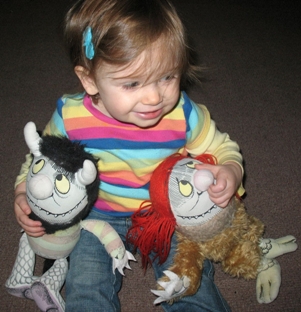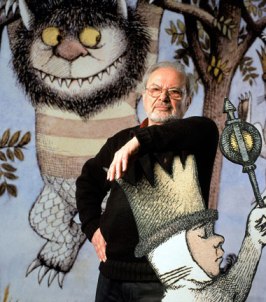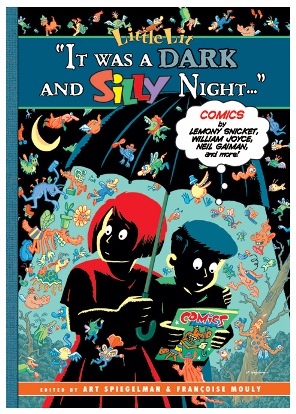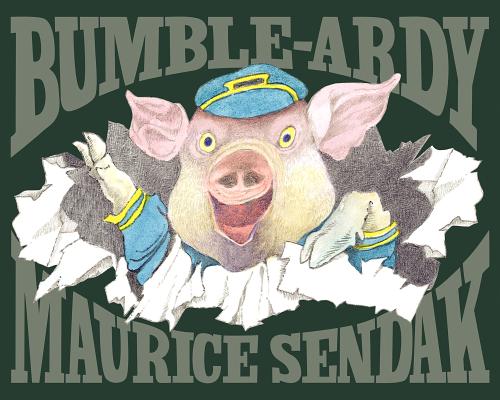Maurice Sendak, a literary giant whose works impacted children of all ages (even the grown ones), died today at the age of 83, due to complications that arose from a recent stroke. I write a lot about “essential” books that every child should have in their home library, but, when I look at my past posts, I realize that I haven’t written that much about Sendak and I think I know why. I think I sometimes forget to mention Sendak or recommend his books, because it just seems like a foregone conclusion to me that EVERYONE knows that you MUST read Maurice Sendak. They don’t need me convincing them to pick up a copy of Where the Wild Things Are or In the Night Kitchen. There is something – or there SHOULD be something – just imprinted in our animal DNA that draws us to Sendak’s works. We recognize the emotions, the expressions, the empathy that are all clearly apparent on the faces of his characters and we connect to them on a deeply resonant level.

My daughter, at age 1 1/2, at the Maurice Sendak exhibit at Philadelphia's Please Touch Children's Museum. You might recognize this image from the header of this blog.
I keep mentioning that The Phantom Tollbooth was the first book that I ever bought for my daughter, but, what I don’t mention is that I didn’t have to buy her a copy of Where the Wild Things Are because I already had a copy, a copy that I’d bought for myself. As I prepared to leave home for the first time to head for college, for whatever reason, after I was done buying myself bedsheets, a TV, and a computer, I bought myself a hardcover edition of Where the Wild Things Are to keep in my dorm room. And I don’t really know why. Maybe it was something to help me remember my childhood. Maybe it was the equivalent of a literary security blanket. Maybe I was hoping to look deep to college girls and subtly let them know that I was ready to let the “wild rumpus start.” But, my strange motivations aside, I think it says a lot that I couldn’t picture living alone, in my own living space for the first time in my life, without a copy of Where the Wild Things Are ready and available to me whenever I needed it.
That’s the real magic of Sendak. He has so woven his stories into our collective unconscious that it now seems bizarre that there ever were generations in the past that didn’t have Where the Wild Things Are, In the Night Kitchen, or Outside Over There available for their children. While I’m happy that the world will always have his books to cherish for eons to come, I’d admit, it does feel very strange to no longer have the man himself, creating new and vibrant works and constantly reminding children to “Live your life, live your life, live your life.”
As a small tribute to the memory of the great man, I assembled this brief collection of videos that, I think, do a nice job of really showing the universal impact, importance, and grand, unfettered joy of Maurice Sendak and his wonderful works. He will be missed.
Tell Them Anything You Want is a fantastic 40-minute documentary on Sendak assembled by Spike Jonze and Lance Bangs, which was released to accompany Jonze’s 2009 big-screen, live-action version of Where the Wild Things Are. This is long, but beautiful – with some wonderful interviews with Sendak himself. [UPDATE: Earlier today, I embedded a link to a full version of Tell Them Anything You Want on YouTube. That link has since been removed due to a copyright claim. In its place, until they take it down, I present this still-pretty-cool, 5-minute excerpt from the documentary.)
Anyone who ever debated Sendak‘s cultural importance should watch this great video of President Obama reading Where the Wild Things Are at the 2009 White House Easter Egg Roll.
A longer excerpt of some spirited interviews with Sendak talking about his life and career, which is taken from a DVD released by the Rosenbach Museum & Library in Philadelphia, which is the “sole repository of the original artwork of famed author and illustrator Maurice Sendak and a foremost authority on all things Sendak.”
Anita Silvey, the children’s lit expert behind one of my favorite websites, The Book-a-Day Almanac, gives a wonderful overview of Maurice Sendak‘s personal history and literary career. This is a nice introduction to Sendak for those who don’t know much about the man behind his famous works.
{ 0 comments }



